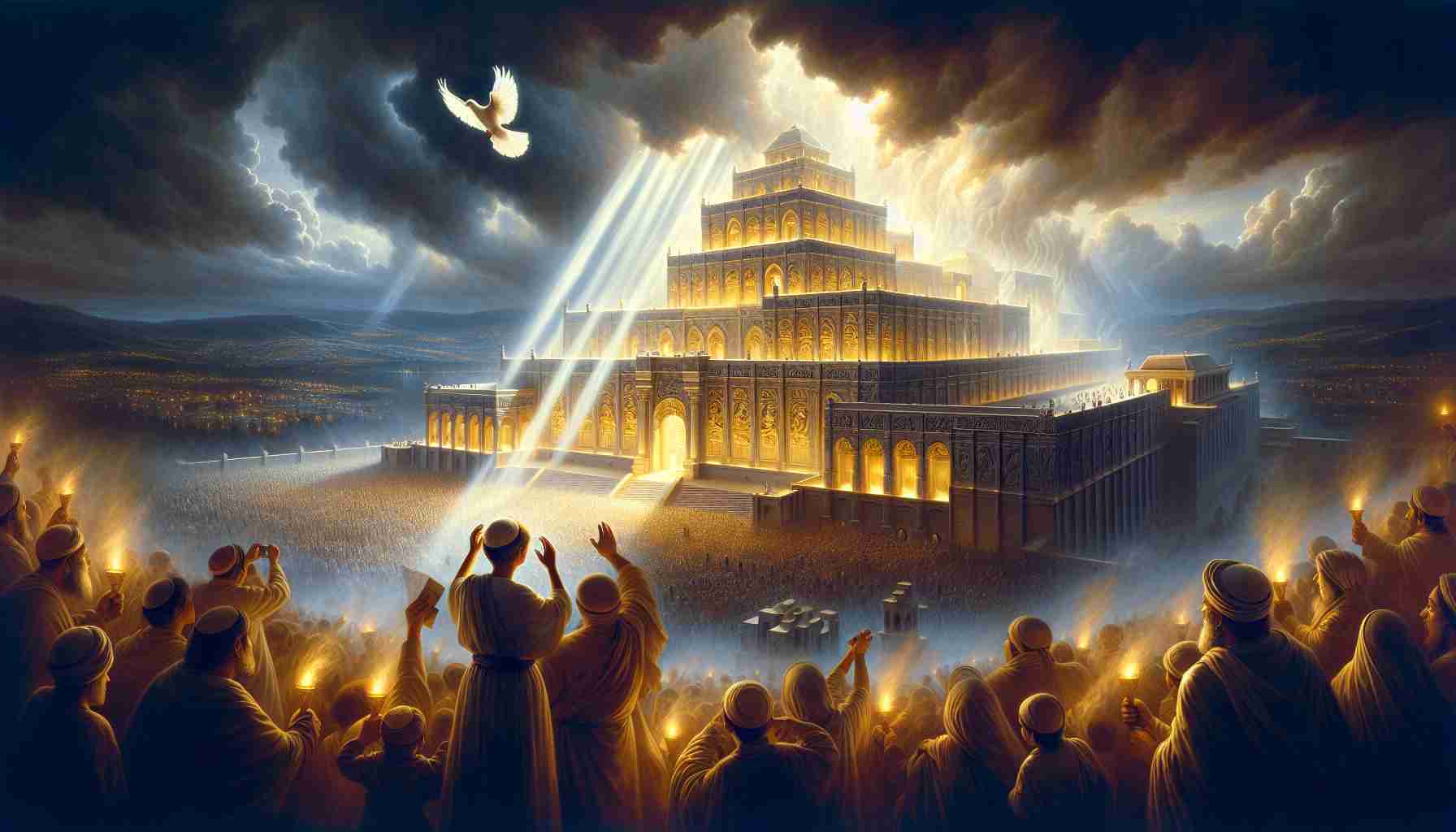

They say a man is closest to Heaven when his knees touch the ground. That day, I saw it with my own eyes.
I was a stonecutter by trade, one of hundreds who labored in the sun for years to help build King Solomon’s Temple in Jerusalem—the holy city of our people. My name won’t be remembered, but my hands remember the weight of every slab, the hum of the chisel, and the whispered prayers carved into the foundation blocks. My back ached from work, but my heart burned with pride.
The building was finally finished. Cedars from Lebanon had been set in place, gold had been hammered onto the Holy of Holies, and the Ark of the Covenant—the sacred box holding the Ten Commandments given to Moses at Mount Sinai—had been brought in. News spread fast and wide. Everyone came. Leaders of the tribes, elders, priests, singers—thousands gathered. I took a place at the edge of the courtyard, behind a column, pressed shoulder to shoulder with others like me. Common men with calloused hands and wide eyes.
Then King Solomon stepped forward. This was no ordinary king. The son of David himself. People said God had granted him more wisdom than any man had ever known. But even he looked humbled that day. When he raised his hands toward the sky, the entire crowd fell silent. You could hear the cry of a dove.
Then he began to pray.
He didn’t boast of the gold or the design. No, Solomon’s voice trembled as he asked God to turn His ear to this place. He begged for mercy. He prayed for the traveler, for the sinner, for the hungry, for Israel—and even for the stranger who would come seeking the God of Heaven. His voice grew steadier, louder. Each word soaked deep into me, like water into sun-cracked earth.
I remember one part most of all. He said, “Even the highest heaven cannot contain You—how much less this Temple I have built!” And I broke. Right there, behind my column. Because after all the hammering and hauling, I’d believed the Temple was where God now lived. But in that moment, I understood: it wasn’t about the stone. It was about our hearts.
And just then, the cloud descended.
A thick cloud filled the sanctuary. The priests had to stop. They couldn’t even stand. People gasped, some cried out. But no one ran. We knew what we were witnessing. God Himself had entered the Temple. Not because the walls were tall or filled with gold, but because the people had gathered in one heart, with one voice.
I dropped to my knees, pressing my forehead to the marble floor. I didn’t feel separate anymore—from the king, from the priests, or from God.
That day, I left the Temple with sore knees, tear-streaked cheeks, and a changed heart. I had built a house of God with my hands. But in that moment, He had built something inside me.
They say a man is closest to Heaven when his knees touch the ground. That day, I saw it with my own eyes.
I was a stonecutter by trade, one of hundreds who labored in the sun for years to help build King Solomon’s Temple in Jerusalem—the holy city of our people. My name won’t be remembered, but my hands remember the weight of every slab, the hum of the chisel, and the whispered prayers carved into the foundation blocks. My back ached from work, but my heart burned with pride.
The building was finally finished. Cedars from Lebanon had been set in place, gold had been hammered onto the Holy of Holies, and the Ark of the Covenant—the sacred box holding the Ten Commandments given to Moses at Mount Sinai—had been brought in. News spread fast and wide. Everyone came. Leaders of the tribes, elders, priests, singers—thousands gathered. I took a place at the edge of the courtyard, behind a column, pressed shoulder to shoulder with others like me. Common men with calloused hands and wide eyes.
Then King Solomon stepped forward. This was no ordinary king. The son of David himself. People said God had granted him more wisdom than any man had ever known. But even he looked humbled that day. When he raised his hands toward the sky, the entire crowd fell silent. You could hear the cry of a dove.
Then he began to pray.
He didn’t boast of the gold or the design. No, Solomon’s voice trembled as he asked God to turn His ear to this place. He begged for mercy. He prayed for the traveler, for the sinner, for the hungry, for Israel—and even for the stranger who would come seeking the God of Heaven. His voice grew steadier, louder. Each word soaked deep into me, like water into sun-cracked earth.
I remember one part most of all. He said, “Even the highest heaven cannot contain You—how much less this Temple I have built!” And I broke. Right there, behind my column. Because after all the hammering and hauling, I’d believed the Temple was where God now lived. But in that moment, I understood: it wasn’t about the stone. It was about our hearts.
And just then, the cloud descended.
A thick cloud filled the sanctuary. The priests had to stop. They couldn’t even stand. People gasped, some cried out. But no one ran. We knew what we were witnessing. God Himself had entered the Temple. Not because the walls were tall or filled with gold, but because the people had gathered in one heart, with one voice.
I dropped to my knees, pressing my forehead to the marble floor. I didn’t feel separate anymore—from the king, from the priests, or from God.
That day, I left the Temple with sore knees, tear-streaked cheeks, and a changed heart. I had built a house of God with my hands. But in that moment, He had built something inside me.